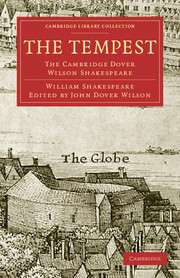THE STAGE-HISTORY OF THE TEMPEST
Published online by Cambridge University Press: 07 September 2010
Summary
Peter Cunningham (Extracts from the Accounts of the Revels at Court, 1842, p. 210) published the following entry, which he professed to have discovered in the Revels Accounts for the year 1611:
By the Kings Players: Hallomas nyght was presented att Whithall before ye kings matie A play called the Tempest.
This entry was long suspected or declared a forgery; but its genuineness has been recently affirmed by Mr Ernest Law (Some Supposed Shakespeare Forgeries, 1911); and, if Mr Law's arguments stand the test of further critical exploration of the problem, the entry may be regarded as the earliest record of a performance of The Tempest. There is some reason for believing that the performance at Court had been preceded by one or more public performances at the Blackfriars play-house. Malone states, on the authority of the Vertue MSS, that the play was acted by the King's Company before Prince Charles, the Princess Elizabeth and the Elector Palatine, in the beginning of the year 1613. In the preface (dated December 1, 1669) to The Tempest, or The Enchanted Island, Dryden states that ‘the play itself had formerly been acted with success in the Black-Fryers.’
The subsequent stage-history of The Tempest is almost entirely a tale of distortion and misuse. The Tempest, or The Enchanted Island (published in 1670) was a version of the play made by William D'Avenant, with some help from Dryden (Cambridge History of English Literature, VIII. 28, 398).
- Type
- Chapter
- Information
- The TempestThe Cambridge Dover Wilson Shakespeare, pp. 109 - 111Publisher: Cambridge University PressPrint publication year: 2009First published in: 1921



